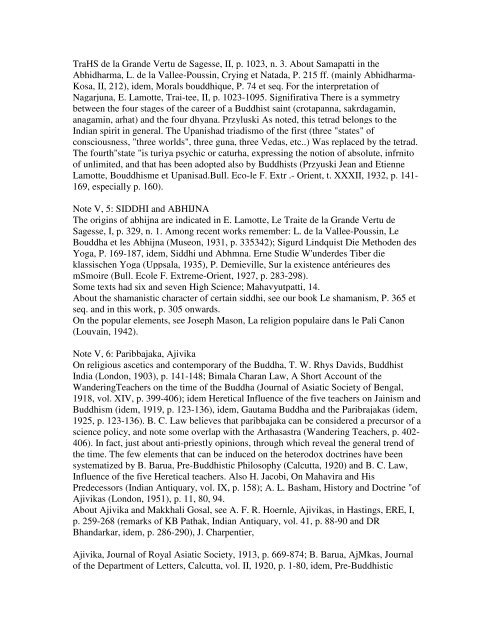Mircea Eliade YOGA IMMORTALITY AND ... - Brihaspati.net
Mircea Eliade YOGA IMMORTALITY AND ... - Brihaspati.net
Mircea Eliade YOGA IMMORTALITY AND ... - Brihaspati.net
You also want an ePaper? Increase the reach of your titles
YUMPU automatically turns print PDFs into web optimized ePapers that Google loves.
TraHS de la Grande Vertu de Sagesse, II, p. 1023, n. 3. About Samapatti in the<br />
Abhidharma, L. de la Vallee-Poussin, Crying et Natada, P. 215 ff. (mainly Abhidharma-<br />
Kosa, II, 212), idem, Morals bouddhique, P. 74 et seq. For the interpretation of<br />
Nagarjuna, E. Lamotte, Trai-tee, II, p. 1023-1095. Signifirativa There is a symmetry<br />
between the four stages of the career of a Buddhist saint (crotapanna, sakrdagamin,<br />
anagamin, arhat) and the four dhyana. Przyluski As noted, this tetrad belongs to the<br />
Indian spirit in general. The Upanishad triadismo of the first (three "states" of<br />
consciousness, "three worlds", three guna, three Vedas, etc..) Was replaced by the tetrad.<br />
The fourth''state "is turiya psychic or caturha, expressing the notion of absolute, infrnito<br />
of unlimited, and that has been adopted also by Buddhists (Przyuski Jean and Etienne<br />
Lamotte, Bouddhisme et Upanisad.Bull. Eco-le F. Extr .- Orient, t. XXXII, 1932, p. 141-<br />
169, especially p. 160).<br />
Note V, 5: SIDDHI and ABHIJNA<br />
The origins of abhijna are indicated in E. Lamotte, Le Traite de la Grande Vertu de<br />
Sagesse, I, p. 329, n. 1. Among recent works remember: L. de la Vallee-Poussin, Le<br />
Bouddha et les Abhijna (Museon, 1931, p. 335342); Sigurd Lindquist Die Methoden des<br />
Yoga, P. 169-187, idem, Siddhi und Abhmna. Erne Studie W'underdes Tiber die<br />
klassischen Yoga (Uppsala, 1935), P. Demieville, Sur la existence antérieures des<br />
mSmoire (Bull. Ecole F. Extreme-Orient, 1927, p. 283-298).<br />
Some texts had six and seven High Science; Mahavyutpatti, 14.<br />
About the shamanistic character of certain siddhi, see our book Le shamanism, P. 365 et<br />
seq. and in this work, p. 305 onwards.<br />
On the popular elements, see Joseph Mason, La religion populaire dans le Pali Canon<br />
(Louvain, 1942).<br />
Note V, 6: Paribbajaka, Ajivika<br />
On religious ascetics and contemporary of the Buddha, T. W. Rhys Davids, Buddhist<br />
India (London, 1903), p. 141-148; Bimala Charan Law, A Short Account of the<br />
WanderingTeachers on the time of the Buddha (Journal of Asiatic Society of Bengal,<br />
1918, vol. XIV, p. 399-406); idem Heretical Influence of the five teachers on Jainism and<br />
Buddhism (idem, 1919, p. 123-136), idem, Gautama Buddha and the Paribrajakas (idem,<br />
1925, p. 123-136). B. C. Law believes that paribbajaka can be considered a precursor of a<br />
science policy, and note some overlap with the Arthasastra (Wandering Teachers, p. 402-<br />
406). In fact, just about anti-priestly opinions, through which reveal the general trend of<br />
the time. The few elements that can be induced on the heterodox doctrines have been<br />
systematized by B. Barua, Pre-Buddhistic Philosophy (Calcutta, 1920) and B. C. Law,<br />
Influence of the five Heretical teachers. Also H. Jacobi, On Mahavira and His<br />
Predecessors (Indian Antiquary, vol. IX, p. 158); A. L. Basham, History and Doctrine "of<br />
Ajivikas (London, 1951), p. 11, 80, 94.<br />
About Ajivika and Makkhali Gosal, see A. F. R. Hoernle, Ajivikas, in Hastings, ERE, I,<br />
p. 259-268 (remarks of KB Pathak, Indian Antiquary, vol. 41, p. 88-90 and DR<br />
Bhandarkar, idem, p. 286-290), J. Charpentier,<br />
Ajivika, Journal of Royal Asiatic Society, 1913, p. 669-874; B. Barua, AjMkas, Journal<br />
of the Department of Letters, Calcutta, vol. II, 1920, p. 1-80, idem, Pre-Buddhistic







